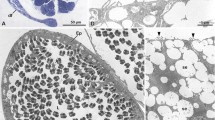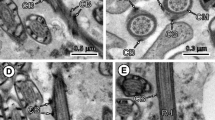Summary
Spermatogenesis inMicrochaetus pentheri (Microchaetidae) follows the familiar pattern known for other oligochaetes. Spermatogenic stages develop around an anucleate cytophore from which they separate as mature spermatozoa. During spermiogenesis the nucleus elongates and becomes surmounted by a complex, elongate acrosome; the flagellar axoneme develops from the distal centriole. The centriole is positioned posterior to the mid-piece, which consists of six mitochondria radially adpressed to form a cylinder about 2 μm long.Microchaetus shows many plesiomorphic features in the structure of its acrosome, which are also seen in two other taxa of the Diplotesticulata,Haplotaxis (Haplotaxidae) andSparganophilus (Sparganophilidae, Aquamegadrili), each of which has the greatest number of plesiomorphies in spermatozoal characters in its group. The Aquamegadrili constitute the sister-group of the Terrimegadrili which contain the earthworm families including the Microchaetidae. The numerous symplesiomorphies in spermatozoal characters do not, however, establish monophyly of microchaetids with haplotaxids and sparganophilids. An apomorphy in the acrosome ofMicrochaetus is its greater length (3.8 μm vs less than 1 μm inHaplotaxis and 1.5 μm inSparganophilus), in this respect resembling other investigated terrimegadriles, the lumbricids, hormogastrids and megascolecids. The axial rod of the acrosome ofMicrochaetus appears apomorphic relative to that ofHaplotaxis, Sparganophilus, lumbricids and megascolecids in lacking an anterior expansion, the capitulum. It ends posteriorly in a cylindrical body, somewhat resembling the node diagnostic of the axial rod of megascolecid earthworms.
Similar content being viewed by others
References
Anderson WA, Weissman A, Ellis RA (1967) Cytodifferentiation during spermiogenesis inLumbricus terrestris. J Cell Biol 32:11–26
Ferraguti M (1983) Annelida — Clitellata. In: Adiyodi KG, Adiyodi RG (eds) Reproductive Biology of Invertebrates, vol II:Spermatogenesis and Sperm Function. Wiley, Chichester, pp 343–376
Ferraguti M (1984) Cytological aspects of oligochaete spermiogenesis. Hydrobiologia 115:59–64
Ferraguti M, Jamieson BGM (1984) Spermiogenesis and spermatozoal ultrastructure inHormogaster (Hormogastridae, Oligochaeta, Annelida). J Submicrosc Cytol 16:307–316
Ferraguti M, Lanzavecchia G (1971) Morphogenetic effects of microtubules. I — Spermiogenesis in Annelida Tubificidae. J Submicrosc Cytol 3:121–137
Jamieson BGM (1971) The aquatic Oligochaeta of the world. Brinkhurst RO, Jamieson BGM (eds) Oliver and Boyd, Edinburgh, Toronto, 860 pp
Jamieson BGM (1978) Phylogenetic and phenetic systematics of the opisthoporous Oligochaeta (Annelida: Clitellata). Evol Theory 3:195–233
Jamieson BGM (1981) Ultrastructure of the Oligochaeta. Academic Press, London, 462 pp
Jamieson BGM (1987) A biological classification of sperm types, with special reference to annelids and molluscs, and an example of spermiocladistics. In: Mohri H (ed) New Horizons in Sperm Cell Research, Japan Science Society Press, Tokyo/Gordon and Breach Science Publishers, New York, pp 311–332
Jamieson BGM (1988) On the phylogeny and higher classification of the Oligochaeta. Cladistics 4:367–410
Jamieson BGM (1991) Fish evolution and systematics: Evidence from Spermatozoa. Cambridge University Press, 320 pp
Jamieson BJM, Daddow L (1979) An ultrastructural study of microtubules and the acrosome in Spermiogenesis of Tubificidae (Oligochaeta). J Ultrastruct Res 67:209–224
Jamieson BGM, Erseus C, Ferraguti M (1987) Parsimony analysis of the phylogeny of some Oligochaeta (Annelida) using spermatozoal ultrastructure. Cladistics 3:145–155
Martinucci GB, Felluga B, Carli S (1977) Development and degeneration of cytophorus during spermiohistogenesis inEisenia foetida (Sav.). Boll Zool 44:383–398
Pickford GE (1975) Contributions to a study of South African Microchaetiniae (Annelida:Oligochaeta). Trans Connecticut Acad 46:13–76
Reger JF (1967) A study on the fine structure of developing spermatozoa from the oligochaete,Enchytraeus albidus. Z Zellforsch Mikrosk Anat 82:257–269
Simms RW (1978) Megadrilacea (Oligochaeta). In: Weger MJA (ed) Biogeography and ecology of southern Africa, vol II, Dr. Junk Publishers, The Hague, pp 661–676
Troyer D, Cameron ML (1980) Spermiogenesis in lumbricid earthworms revisited. I — Function and fate of centrioles, fusion of organelles and organelle movements. Biol Cell 37:273–286
Author information
Authors and Affiliations
Rights and permissions
About this article
Cite this article
Hodgson, A.N., Jamieson, B.G.M. Spermatogenesis in the earthwormMicrochaetus pentheri (Oligochaeta, Microchaetidae). Zoomorphology 112, 57–66 (1992). https://doi.org/10.1007/BF01632995
Received:
Issue Date:
DOI: https://doi.org/10.1007/BF01632995




